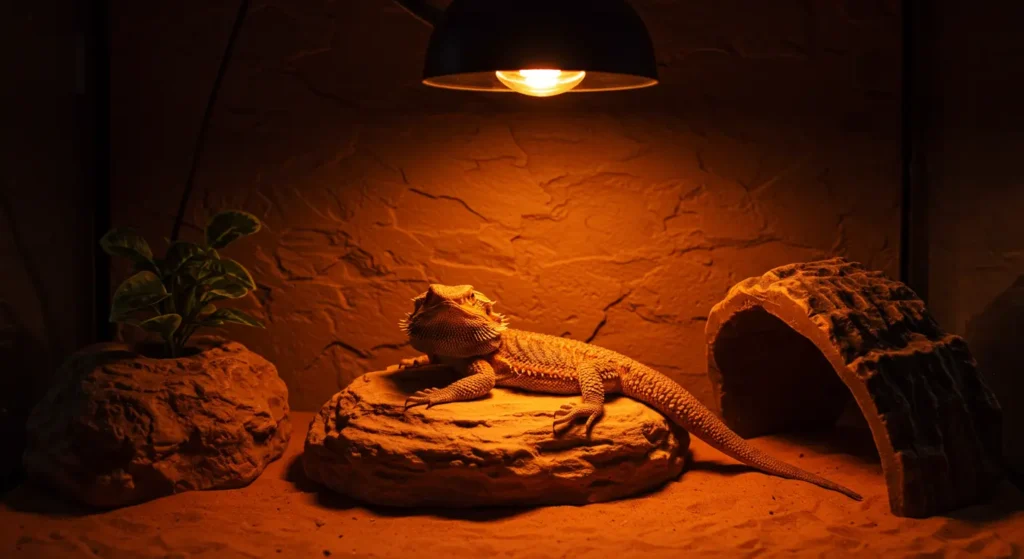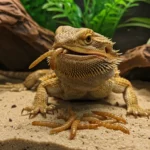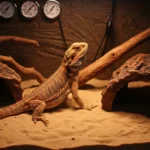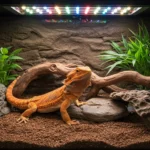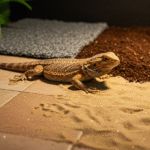Maintaining the right bearded dragon temperature isn’t just a detail—it’s the foundation of your pet’s health and happiness. As cold-blooded reptiles, bearded dragons rely entirely on external heat sources to regulate their body temperature, digest food, stay active, and even ward off illness. If the bearded dragon temperature in your enclosure is off—even slightly—it can lead to serious health issues like lethargy, digestive problems, and stress.
Whether you’re a first-time beardie owner or you’re troubleshooting a current setup, understanding proper heating zones, gradients, and tools is essential. In this guide, we’ll explore the ideal temperature ranges, common heating mistakes, and expert tips to ensure your dragon thrives in a well-regulated environment.
Why bearded dragon temperature Matters for Health and Survival
Maintaining the correct bearded dragon temperature is vital for their survival and overall wellbeing. As cold-blooded reptiles, they rely on external heat sources for thermal regulation, and even slight imbalances can lead to cold stress, overheating symptoms, or serious health complications. In this section, we’ll explore how temperature affects their behavior, metabolism, and long-term health.
How bearded dragon temperature Affects Health and Behavior
The temperature in your bearded dragon’s enclosure directly impacts how they feel and function. When the environment is within the optimal range, your dragon is alert, active, and engaged with its surroundings. However, if the bearded dragon temperature is too low, they may become sluggish, hide more often, or stop eating. On the other hand, extreme heat can cause stress, restlessness, and even aggressive behavior. Proper thermal regulation supports immune function, energy levels, and mood. It also helps maintain a stable biological rhythm, which is essential for natural behaviors like basking and digestion. Ensuring the right heat balance encourages normal daily activity and reduces the risk of illness.
Signs of Overheating or Cold Stress in Bearded Dragons
Recognizing signs of improper temperature in your bearded dragon is critical. If the temperature is too high, your dragon may gape frequently, dig into the substrate, or avoid the basking area. Other signs of overheating include excessive pacing, darkened skin, and rapid breathing. In contrast, if the bearded dragon temperature is too low, your pet may appear lethargic, lose appetite, or spend long periods under the heat source without moving. In severe cases, cold stress can cause weakened muscles and delayed response times. Monitoring these signs helps prevent complications and allows you to take action before health declines.
Health Problems Caused by Improper Bearded Dragon Temperature
Improper heating can cause a range of health problems for your bearded dragon. Constant exposure to low temperatures may lead to metabolic disorders, poor digestion, and respiratory infections. On the flip side, excessive heat can result in dehydration, heat stroke, and organ failure. Young dragons are especially vulnerable, as their bodies depend on consistent warmth for proper growth and development. Without the right bearded dragon temperature, calcium absorption may decrease, increasing the risk of metabolic bone disease. These risks make proper temperature control not just ideal—but absolutely essential for long-term reptile care.
Why Bearded Dragon Temperature Affects Digestion and Daily Activity
Temperature plays a key role in a bearded dragon’s daily rhythm. They need a warm basking zone to properly digest food and absorb nutrients. Without enough heat, their metabolism slows, which can lead to undigested food sitting in the stomach, causing discomfort or impaction. Likewise, activity levels depend on the enclosure’s heat gradient. A dragon kept too cold will avoid movement, reducing their stimulation and engagement with the environment. By providing the right temperature range, you ensure your dragon stays active, alert, and able to process meals efficiently—just like they would in the wild.
Setting the Ideal Heat Zones in the Enclosure
Creating the right heat zones inside your bearded dragon’s enclosure is essential for mimicking their natural desert habitat. A proper temperature gradient—from a warm basking zone to a cooler area—allows your dragon to self-regulate body temperature throughout the day. In this section, we’ll break down how to set up each zone correctly and maintain ideal conditions for every life stage.
Best Basking Temperatures for Baby, Juvenile, and Adult Bearded Dragons
Bearded dragons need different basking temperatures depending on their age. Baby dragons, under six months old, require the highest heat—typically between 100°F and 110°F (37–43°C). This supports their rapid growth and digestion. Juveniles do well with basking spots in the 95°F to 105°F (35–40°C) range. Adult dragons need slightly less heat, ideally around 95°F to 100°F (35–37°C). These differences matter because younger dragons burn more energy and rely heavily on warmth to metabolize food. Too little heat can lead to stunted growth or poor nutrient absorption. It’s important to adjust basking zones as your dragon matures, using a reliable thermometer to track changes. Never guess—measured temperatures help prevent health risks.
Too little heat can lead to stunted growth or poor nutrient absorption. It’s important to adjust basking zones as your dragon matures, using a reliable thermometer to track changes. If you’re caring for a young dragon, be sure to read our full guide on how to take care of a bearded dragon baby, where we cover temperature setup, diet, and enclosure essentials in more detail.
How to Set Up a Stable bearded dragon temperature Gradient
A healthy bearded dragon enclosure should offer a temperature gradient, allowing your reptile to move between warm and cool zones. The warm side, including the basking area, provides essential heat for digestion and activity. The cool side, usually around 75°F to 85°F (24–29°C), gives your dragon a place to rest and cool down. This gradient mimics natural desert conditions and supports proper thermal regulation. Use separate thermometers to monitor both ends of the tank. Without this balance, your dragon may overheat or stay too cold. A consistent gradient gives your pet full control over its body temperature, which is vital for health and comfort.
Safe Bearded Dragon Temperature Setup for Nighttime Conditions
At night, the temperature in your bearded dragon’s tank can drop—but only to a safe limit. Adult dragons can tolerate night temperatures as low as 65°F (18°C), but ideally, it should stay around 70–75°F (21–24°C). If your home gets colder, consider using a ceramic heat emitter (CHE). Unlike regular bulbs, CHEs produce heat without light, so they won’t disturb your dragon’s sleep. Avoid colored night bulbs, as they can cause stress and disrupt circadian rhythms. Use a thermostat to regulate night heat. A steady nighttime temperature helps your dragon rest properly while still supporting digestion and immune function.
How to Monitor Bearded Dragon Temperature Zones with Thermometers
Reliable thermometers are essential for maintaining the correct bearded dragon temperature across the tank. Stick-on strip thermometers are not accurate enough. Instead, use digital probe thermometers or infrared temperature guns. These tools let you check both the surface temperature of the basking spot and the ambient air temperature. Place at least two thermometers in the tank—one on the basking side and one on the cool side. This setup helps ensure your temperature gradient is working as intended. Check readings daily and adjust your heat source if necessary. Accurate monitoring prevents both overheating and dangerous cold spots.
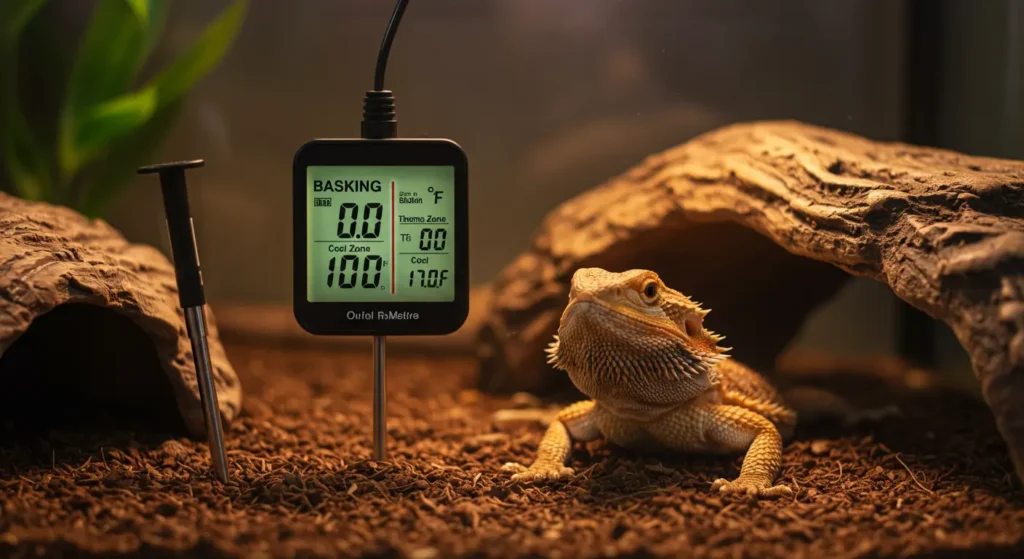
Choosing Heating Equipment for Consistent bearded dragon temperature
To maintain a consistent bearded dragon temperature, you’ll need the right combination of heating tools. From ceramic heat emitters to thermostats and UVB lighting, each component plays a vital role in keeping your dragon healthy and comfortable. In this section, we’ll break down which equipment works best and how to set it up correctly.
Heat Lamps vs Ceramic Heat Emitters: Which Is Best for Your Dragon?
When it comes to heating your bearded dragon’s enclosure, both heat lamps and ceramic heat emitters (CHEs) serve important roles—but in different ways. Heat lamps provide both light and warmth, making them ideal for daytime basking zones. They simulate sunlight and help regulate your dragon’s activity levels. On the other hand, ceramic heat emitters produce only heat, with no visible light. This makes them perfect for maintaining a safe bearded dragon temperature at night without disrupting your pet’s sleep. Many keepers use both tools in tandem—lamps during the day and CHEs at night. Just be sure to pair any heating device with a quality thermostat to avoid overheating. Choose the setup that best fits your home’s conditions and your dragon’s needs.
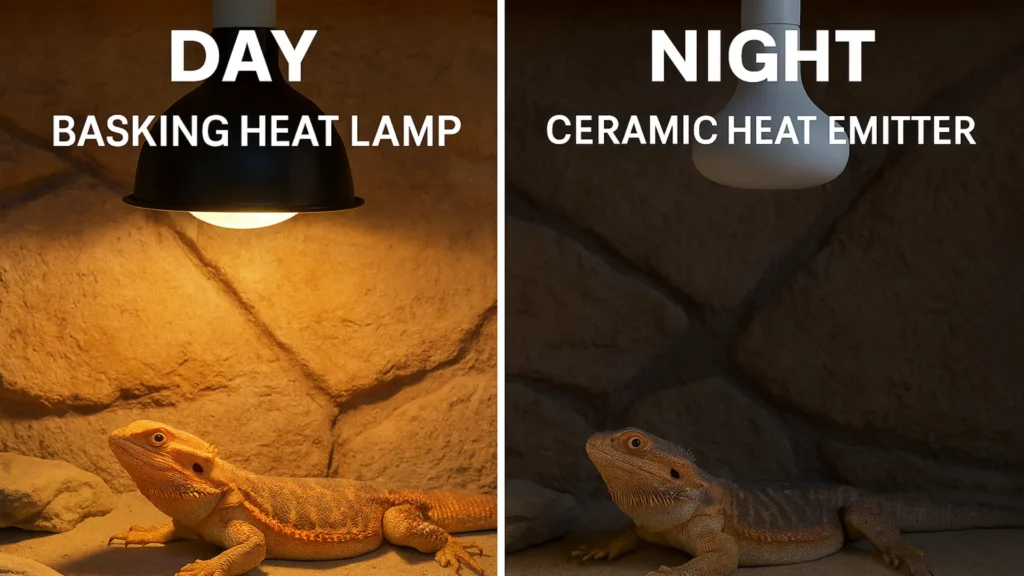
Installing a Thermostat to Control Temperature Fluctuations
A thermostat is one of the most essential tools for maintaining safe and stable temperatures in a bearded dragon tank. Without one, heating devices can quickly overheat the enclosure or fail to maintain the proper gradient. A thermostat allows you to set a maximum and minimum range, so the heating element turns on and off automatically. This ensures your bearded dragon temperature stays within a safe zone day and night. Digital thermostats with probes offer the most precise readings and controls. Always place the probe near the basking spot or where your dragon spends most of its time. By using a thermostat, you reduce the risk of health problems caused by sudden temperature spikes or drops.
Importance of UVB Lighting in Maintaining Heat and Health
While UVB bulbs don’t produce significant heat, they are crucial for your dragon’s health and work closely with your heating setup. UVB lighting helps your bearded dragon synthesize vitamin D3, which is necessary for calcium absorption and bone health. Without UVB exposure, even a perfect bearded dragon temperature won’t be enough to keep your pet healthy. UVB rays also encourage natural behaviors like basking and eating. For best results, use a linear UVB bulb that spans at least two-thirds of the tank. Replace it every 6–12 months, even if it still lights up—UVB output fades over time. Always position the UVB bulb alongside the heat lamp to mimic natural sunlight, supporting your dragon’s full-body wellness.
Why Heat Mats Can Be Harmful to Bearded Dragons
Heat mats may seem like an easy heating option, but they’re not recommended for bearded dragons. Unlike snakes or geckos that absorb heat from below, bearded dragons regulate temperature through their backs by basking under overhead heat. Placing a heat mat under the tank or inside it can create localized hot spots that are hard to control. These areas can burn your dragon’s belly without warning. Additionally, heat mats don’t help maintain a proper temperature gradient, and they often fail to heat large enclosures effectively. Relying on a ceramic heat emitter or basking lamp is much safer and more natural for this desert reptile. Always prioritize top-down heating that mimics the sun’s warmth.
Common Heating Mistakes That Disrupt Enclosure Temperature
Even with the right tools, it’s easy to make heating mistakes that throw off your bearded dragon’s enclosure temperature. Issues like low tank temperatures, reptile overheating, or poor gradient control can lead to long-term health problems. In this section, we’ll cover the most common errors keepers make—and how to fix them quickly.
Misplaced Bulbs and Incorrect Wattage: What You Need to Know
One of the most common causes of temperature imbalance in a bearded dragon tank is improper bulb placement or using the wrong wattage. If your heat lamp is too far from the basking spot, it won’t reach the required surface temperature. On the other hand, placing it too close can cause overheating or burns. The wattage of the bulb should match the size of the tank and the room temperature. For most enclosures, bulbs between 75 and 150 watts work best, depending on height and ventilation. Always position the bulb above a designated basking area and use a digital thermometer to measure the surface below. Avoid placing bulbs directly over hides or water bowls, as this can disrupt your dragon’s natural behavior. Proper bulb selection and placement ensure safe, even heating.
How to Warm a Bearded Dragon Tank During Cold Seasons
During winter or in colder climates, keeping your bearded dragon’s tank warm can be challenging. Indoor temperatures may drop significantly at night, causing the bearded dragon temperature to fall below safe levels. To combat this, you can use a ceramic heat emitter (CHE), which provides heat without light and is ideal for nighttime use. Insulating the tank with foam panels or a thermal cover can also help retain heat. Avoid using space heaters or heat mats, which may create uneven zones or pose safety risks. Instead, make sure your basking bulb is high enough in wattage to compensate for the cold air. Always monitor with a digital thermometer and adjust your setup gradually. A thermostat can automate the process and keep your tank within the correct range even when temperatures fluctuate outside.
Preventing Overheating in Small Rooms or During Summer
Bearded dragon tanks located in small rooms or exposed to direct sunlight can easily become too hot during the summer. Excessive heat leads to reptile overheating, stress, and dehydration. To prevent this, avoid placing the enclosure near windows or heat sources. Consider using a lower wattage bulb or raising the fixture slightly to reduce intensity. Ensure proper airflow by adding ventilation to the tank or using a fan in the room (never directly on the tank). During heatwaves, turning off the basking lamp for short periods or switching to a ceramic heat emitter may help regulate the enclosure temperature. Always keep an eye on your thermometer and provide plenty of fresh water. Even slight overheating can affect your dragon’s health, so consistent monitoring is essential.
Diagnosing and Fixing Uneven Temperature Zones in the Tank
A well-maintained bearded dragon habitat should have a clear temperature gradient, but many tanks suffer from uneven heating. This creates hot and cold spots, making it difficult for your dragon to regulate its body temperature. The most common causes include poor bulb placement, lack of insulation, or using a single thermometer. To fix this, place digital thermometers or probes at both ends of the enclosure—one on the basking side and one on the cool side. Make sure the heat source is directed toward the basking area and not spreading unevenly. Reflectors or domes can help focus the warmth. Use a thermostat to manage fluctuations and keep your gradient consistent. Fixing uneven zones ensures that your dragon can move freely between warm and cool areas for proper thermal regulation.
Long-Term Temperature Maintenance in Your Dragon’s Habitat
Maintaining the right bearded dragon temperature isn’t just about setup—it’s about consistency. Long-term success depends on vivarium stability, regular thermostat calibration, and adjusting for seasonal changes. In this section, we’ll explore how to keep your dragon’s environment steady and safe all year round.
How Often Should You Check Your Bearded Dragon’s Tank Temperature?
Monitoring your bearded dragon’s tank temperature should be part of your daily routine. Temperature can fluctuate throughout the day due to changes in room conditions, heating cycles, or even weather. It’s important to check both the basking spot and the cool side at least twice a day—once in the morning and again in the evening. This helps ensure that the temperature gradient remains stable. If you use a digital thermometer with a probe or a thermostat, monitor its readings regularly and recalibrate when needed. Spot-checking with an infrared thermometer once a week can help confirm your setup is working properly. Consistent monitoring reduces the risk of thermal imbalance and gives your bearded dragon the best environment to thrive.
Best Reptile Thermometers for Monitoring Basking and Cool Zones
Choosing the right thermometer is key to keeping your bearded dragon enclosure safe and comfortable. Stick-on thermometers are often inaccurate and should be avoided. Instead, use digital probe thermometers to measure both surface and ambient temperatures. Place one probe directly under the basking light and another on the cool side of the tank. This allows you to monitor the temperature gradient in real time. Infrared temperature guns are also helpful for quick spot checks across different areas of the tank. These tools are especially useful for larger enclosures where heat can vary by section. Invest in reliable devices—temperature control is not the place to cut corners. Accurate readings mean better decisions and a healthier dragon.
Keeping Stable Heat Levels Throughout the Year
Seasonal shifts in room temperature can affect your vivarium’s thermal stability. During colder months, your heat sources may need to run longer or at higher wattage. In contrast, summer may require reducing bulb intensity to prevent overheating. The goal is to maintain consistent bearded dragon temperature ranges regardless of the season. A thermostat with automatic on/off control makes this much easier. You should also check for drafts near the tank or heat loss from poor insulation. Consider using foam panels or insulating covers if the enclosure is placed near windows or doors. Stability matters more than exact numbers—sudden changes can stress your reptile and impact health over time.
Adjusting Enclosure Heating for Seasonal Temperature Changes
As seasons change, so should your heating setup. Winter may require a higher-wattage ceramic heat emitter or an additional daytime basking bulb to maintain optimal warmth. On the other hand, summer might call for lower wattage bulbs, raising the lamp higher, or improving airflow to prevent reptile overheating. Use a thermostat to manage these changes automatically when possible. Regularly test and recalibrate all equipment before seasonal transitions begin. Even small temperature shifts can affect digestion, sleep, and behavior. By planning ahead and making slight adjustments, you can protect your bearded dragon from thermal stress and ensure year-round comfort.
Frequently Asked Questions About bearded dragon temperature
What is the ideal temperature range for a bearded dragon during the day?
Bearded dragons need a daytime basking area of 95–110°F (35–43°C), depending on their age. The cool side should remain between 75–85°F (24–29°C).
What should the bearded dragon temperature be at night?
At night, the temperature can safely drop to 65–75°F (18–24°C). Use a ceramic heat emitter if your home gets colder than this range.
What temperature will kill a bearded dragon?
Temperatures below 60°F (16°C) for prolonged periods can be fatal. Likewise, constant exposure to heat above 115°F (46°C) can cause overheating and death.
Do baby bearded dragons need more heat than adults?
Yes. Babies need higher basking temperatures—up to 110°F (43°C)—to support digestion and growth. Adults thrive at slightly lower basking temps around 95–100°F (35–38°C).
Can I use a heat mat to warm my bearded dragon tank?
No. Bearded dragons absorb heat from above. Heat mats can cause burns and don’t provide the gradient they need. Overhead heating is the safest choice.
How do I monitor bearded dragon temperature accurately?
Use digital probe thermometers or an infrared temperature gun. Place one probe on the basking surface and another on the cool side of the tank.
What is the proper humidity level for a bearded dragon?
Keep humidity between 30–40%. High humidity can cause respiratory infections, even if the temperature is correct.
Conclusion
Maintaining the proper bearded dragon temperature is one of the most important aspects of responsible reptile care. From creating a balanced heat gradient to choosing the right equipment and adjusting for seasonal changes, every detail matters. By staying consistent with your temperature setup and monitoring it regularly, you’ll ensure your bearded dragon remains healthy, active, and stress-free. Whether you’re caring for a baby or an adult, a stable thermal environment is key to helping your pet thrive.
For more guidance on your dragon’s overall wellness, don’t miss this expert-backed article on how to tell if your bearded dragon is healthy by Zen Habitats.

